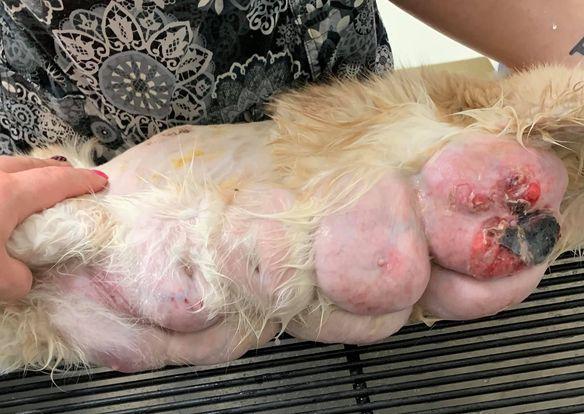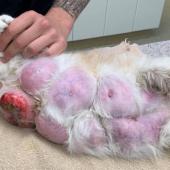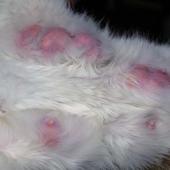Cat Mastitis (inflammation of the mammary glands)

Mastitis is a painful inflammation of the mammary glands, predominantly affecting lactating female cats. Mastitis (sore breasts) can be a very unpleasant condition. Although not usually life-threatening, mastitis can be very distressing for your pet. It is important to seek veterinary advice as soon as possible because the use of antibiotics, whenever indicated by your veterinarian, can be very helpful in resolving the condition. Mastitis can worsen quickly and have serious consequences if not promptly addressed. This article aims to shed light on the causes, symptoms, and treatment options for cat mastitis, helping cat parents recognize and address this condition promptly.
What is mastitis?
Mastitis means that the mammary tissue (breast tissue) is inflamed. Usually only one or two teats are affected. The most common cause is a bacterial infection that generally occurs in queens after they have given birth and while they are feeding kittens. A non-infectious mastitis may also develop when the kittens are weaned suddenly and the mammary glands become warm, swollen and hot because the milk is not being drained by feeding kittens.
Causes of Cat Mastitis
Mastitis in cats primarily occurs due to bacterial infection, commonly stemming from blocked milk ducts. The bacteria, often Staphylococcus aureus, can enter the mammary glands through small cracks or wounds on the skin, causing inflammation. Poor hygiene, inadequate nursing, or an underlying illness compromising the cat's immune system can increase the risk of mastitis.
What are the signs of mastitis?
The cat's refusal to feed her kittens is usually the first indication you will notice. When they get close, she can snap at them. It's possible that the kittens' unusually high levels of restlessness and wailing are due to hunger. It's possible that your cat's mammary tissue is bloated, red, or discolored. It may also feel unpleasant to the touch and feel hot or cold in certain situations. You may see a small quantity of clotted milk, blood, or pus come out of your nipples if you gently squeeze them. Mastitis frequently causes cats to feel ill, stop eating, and have a temperature. In extreme situations, the mammary gland may get sores that scab over or ulcers that leak pus.
As the condition worsens, the infection may reach your cat's bloodstream, which could result in sepsis symptoms like depression and vomiting.
Recognizing the signs of mastitis is crucial for early intervention. Some common symptoms include:
- Swollen, Red, or Painful Mammary Glands: The affected area may appear larger than usual, feel warm to the touch, and cause discomfort to the cat.
- Lethargy and Loss of Appetite: Cats with mastitis may exhibit a lack of energy and interest in food due to the pain and discomfort associated with nursing.
- Fever: A spike in body temperature is a common response to bacterial infection and inflammation.
- Discharge: Pus or bloody discharge from the nipples is a clear indication of mastitis.
- Agitation and Restlessness: Cats in pain often display behavioral changes, such as increased irritability and restlessness.
How will my veterinarian know what is wrong with my cat?
Based on your description of the symptoms and the fact that your cat is nursing babies, your veterinarian will likely think that your cat has mastitis. In addition to inspecting your cat, your veterinarian might evaluate the mammary tissue using ultrasound technology and possibly take aseptic milk secretions at that time.
Testing on a sample of milk will reveal the presence of any bacterial infections. If this is the case, a sample might be sent to a lab to check if bacteria can grow, allowing tests to be conducted in order to determine which medicines are best for treating the infection. Additional testing, possibly including blood work, may be performed if your pet exhibits symptoms of a general disease, such as fever or decreased appetite.
What can I do to prevent my cat developing mastitis?
Mastitis can affect every breed of cat, any age or size, and new or seasoned moms alike. A bacterial infection that enters the breast tissue through the nipple is typically the cause of mastitis. If a cat feeds in an unsanitary environment or has experienced significant nipple trauma, there is an increased risk of developing mastitis. This is why it's critical to maintain a clean nursing box area and to get rid of any soiled bedding as soon as you can.Cats should be closely observed after kittening to make sure the kittens are nursing in every gland. "Neglected" glands run the risk of engorgement from stagnant milk, which puts them at risk for mastitis. In that case, help feed the kittens so that they are directed to suckle on engorged glands.
Strong-feeding and persistently nursing kittens have the potential to leave their teat orifices open, which allows bacteria to enter. Kittens can, if possible, be separated from their mother for a few hours following feeding in order to give their glands enough time to relax.
In rare cases, the infection travels via the blood and becomes embedded in the breast tissue. Mastitis can also occur in queens when there is a prolonged build-up of milk in the mammary glands as a result of the kittens' poor eating habits, particularly following an abrupt weaning or the kittens' deaths.
How is mastitis treated?
Your doctor could recommend an antibiotic course if your pet develops bacterial mastitis. Most of the time, the issue should go away a few days after the treatment begins. Even if your cat appears to be fully recovered, it is crucial that you keep giving the medicine until the entire course is completed. Treatment may not be effective again and the disease may return quickly if you stop too soon.
In certain extremely severe cases, the mammary tissue begins to die or produce abscesses; gangrene may then ensue. Due to the potentially fatal nature of this ailment, your pet may need to be brought to the hospital for intensive care. Surgery may also be necessary to remove some of the injured mammary tissue.
If milk suppression is necessary, your veterinarian can discuss this with you and prescribe medication to help. This will rely on the cause of the mastitis and the kittens' developmental stage.
Treatment Options:
-
Antibiotics: Bacterial mastitis is typically treated with a course of antibiotics to eliminate the infection. It's crucial to administer the medication as prescribed by the vet.
-
Pain Management: Pain relievers may be prescribed to alleviate discomfort and help the cat feel more at ease.
-
Warm Compresses: Applying warm, damp compresses to the affected area can reduce swelling and promote drainage.
-
Proper Nursing Care: If the cat is nursing kittens, it's essential to ensure the kittens are still allowed to nurse. The vet may provide guidance on proper nursing techniques and frequency to prevent further complications.
-
Surgery: In severe cases or if an abscess forms, surgical drainage of the affected gland may be necessary.
-
Hormonal supplementation : may decrease or suppress the milk production
Is there anything else I can do to help?
Certain painkilling medications may be prescribed by your veterinarian. To lessen pain and inflammation, the mammary tissue can be packed alternatively with heat and cold dressings. Your pet can wear a t-shirt to help keep the dressings in place.
The kittens should be taken from the mother at first, and they should be fed more milk. Every six hours, your veterinarian could advise you to manually milk the afflicted glands. This promotes healing by maintaining blood flow to the gland. Nonetheless, it's helpful to let the kittens nurse again as soon as possible to maintain the mammary glands empty. Selecting the right antibiotic is crucial since most medicines will find their way into milk. If kittens are to nurse, only antibiotics that are safe for kitten use should be administered. Kittens given antibiotics must be regularly watched for symptoms of diarrhea or other illnesses, and if they do, they may need to be taken away from their mother.
Will my cat get better?
When treated promptly, most cats with simple mastitis recover quite fast, often beginning to feel better within a few days. On the other hand, cats may not survive more severe cases requiring emergency care, and if they do, their recuperation from the sickness and operation may take many weeks.
Conclusion
Cat mastitis is a painful condition that requires prompt veterinary care. Being vigilant about your cat's health, ensuring proper hygiene, and seeking immediate medical attention if you notice any symptoms can significantly contribute to a successful recovery. With the right treatment and care, your cat can resume her normal activities and continue to be the happy, healthy pet you adore.






